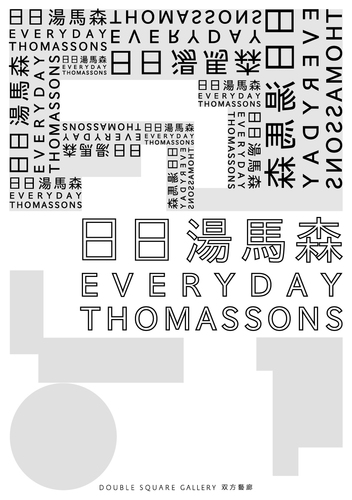Everyday Thomassons
4/23 (Sat) - 5/22/2016 (Sun)
Shih-Tai Chan, Wan-Jen Chen, Chien-Ju Chia, Yang-Cong Hsu, Chao-Hao Liao, Chien-Chung Liao, Takahiko Suzuki, Sih-Chin Wu

Dates: 2016.04.23 – 2016.05.22
Venue:Double Square Gallery 1F
Opening: 2016.04.23 Sat. 15:00
Artists Talk: 2016.05.15 Sun. 15:00
Everyday Thomassons will be on view at Double Square Gallery from 23 April to 22 May 2016. Curated by Tzu-Chieh Jian, this exhibition features the artworks by eight Taiwanese contemporary artists par excellence, namely Shih-Tai Chan, Wan-Jen Chen, Chien-Ju Chia, Onion Hsu, Chao-Hao Liao, Chien-Chung Liao, Takahiko Suzuki and Sih-Chin Wu.
The term “Thomasson” comes from the art of Street Observation. It is based on the name of Gary Thomasson, a star player in Major League Baseball. He was hired by Yomiuri Giants with a generous salary package in 1981 but had since frequently struck out and ergo had no choice but to end his career in professional baseball. This case was then defined as “Thomasson” in 1985 by Japanese avant-garde artist Genpei Akasegawa, editor Matsuda Tesuo, and illustrator Minami Shinbo in their edited book The Basics of Street Observation. They use this term to refer to “the detritus of urban architecture.” These useless objects tenaciously strive to make their presence felt even though they have been deprived of their original functions in the course of time. Scholars of street observation not only aim to find Thomassons from the perspective of passers-by, but also construe the self-eliminating action of daily observation as a behavior that helps stretch their horizons beyond the arts.
The curator Tzu-Chieh Jian employs the term “Thomasson” to refer to the daily feelings about objects that have existed somewhere but been often ignored, be they defunct objects or the sense of impotence. These feelings are a common part of urban life’s rich tapestry. Besides, the curator uses “Thomassons” with the adjective “everyday” to underscore the subjective nature of Thomassons, for we are becoming someone by losing something.
By virtue of the thematic axis of Everyday Thomassons, the curator gives prominence to Thomasson’s power in evoking empathy. In other words, the change of perspectives may breathe new life into these out-of-function artificial objects. More importantly, this exhibition revolves around the question as to why the objects deemed redundant or useless by the social system in a modernized city where stages and characters are forged by customary practices can evoke our empathy with minimum effort. In addition to expecting a re-written history that provides new interpretations, this exhibition seeks to highlight the sentimental factors that touch upon individuals. One who exerts the power of empathy tends to be somewhat miserable at the beginning, but will probably end up with finding great delight. “The quintessence of street observation is the point at which you might have a feeling of melancholy when you see a worn-out manhole cover, have a sense of pity when you see the fliers on the walls or the truncated poles on the roadside reminiscent of the cut-off penis and testicles in the Sada Abe event, and indistinctly see the microcosm of the boundless universe when you stare at the chickweed thriving out of the abandoned and rusted iron-made hand pump,” said Terunobu Fujimori, a member of the Street Observation Society.
The curator believes that the formal “metamorphoses” of the media of contemporary art actually proceed with a subtle touch of “Thomasson,” yet we have been trained to focus on either the metamorphosed grandeur or the social factors that drag the defunct objects into an abyss. As a result, Everyday Thomassons tries to rekindle our empathy for the disused objects and those individuals who serve as tiny gear wheels of the societal apparatus. It is the only way for us to open up the possibilities of change.
Born in 1974, the curator Tzu-Chieh Jian earned his doctoral degree in art creation and theory from Tainan National University of the Arts and teaches in the Department of Fine Arts, National Kaohsiung Normal University. He served as a nominator for the 14th and 15th Taishin Arts Award. He started his first job in an advertisement company as an account executive, and had since taught as a member of adjunct faculty at two art universities in northern Taiwan for almost a decade. During that period, he used to work concurrently as a project manager at the “Intransigent at the Beginning Studio,” a senior editorial writer of ARTCO, and an observer of 2015 Kaohsiung Awards. He also founded the artist group “Post-Eight” in 2000, since when it has participated in prestigious domestic and international exhibitions. His major curatorial works include In the Flesh (2015) at Chine Gallery, New York Travel Program (2012) at Kuandu Museum of Fine Arts, Looking Up! Looking Down! (2009) at Eslite Gallery, and [Ctrl]Z (2008) at inFIDI space.